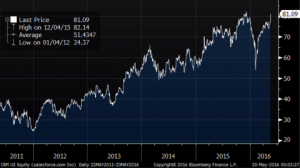We’ve always been a little cynical about Salesforce’s business model. We don’t think it’s sustainable to keep delivering ever more expensive software at a loss when the market is being eroded by free and open source software. One thing we’re not is financial analysts, but fortunately we know people who are. A good friend of the company sent me the following article, which is very interesting (attributions at the foot):
My favorite example of a “story stock” is Salesforce.com (ticker CRM), a $55 billion market cap technology company with 19,000 employees and about $6.5 billion in revenues. I’m pretty sure that Salesforce.com has never had a single penny of GAAP earnings in its existence (in FY 2016 the company lost $0.07 per share on a GAAP basis). Instead, the company is valued on the basis of non-GAAP earnings, but even there it trades at about an 80x multiple (!) of FY 2017 company guidance of $1.00 per share. Salesforce.com is blessed with a master story-teller in its CEO, Marc Benioff, who – if you’ve ever heard him speak – puts forth a pretty compelling case for why his company should be valued on the basis of bookings growth and other such metrics. Of course, the skeptic in me might note that it is perhaps no great feat to sell more and more of a software service at a loss, particularly when your salespeople are compensated on bookings growth, and the cynic in me might also note that for the past 10+ years Benioff has sold between 12,500 and 20,000 shares of CRM stock every day through a series of 10b5-1 programs. But hey, that’s why he’s the multi-billionaire (and a liquid multi-billionaire, to boot) and I’m not. Here’s the 5-year chart for CRM:

Not bad. Up 138% over the past five years. A few ups and downs, particularly here at the start of 2016, although the stock has certainly come roaring back. But when you dig a little deeper …
There are 1,272 trading days that comprise this 5-year chart. 21 of those trading days, less than 2% of the total, represent the Thursday after Salesforce.com reports quarterly earnings (always on a Wednesday after the market close). If you take out those 21 trading days, Salesforce.com stock is up only 35% over the past five years. How does this work? What’s the causal process? Every Wednesday night after the earnings release, for the past umpteen years, Benioff appears on Mad Money, where Cramer’s verdict is always an enthusiastic “Buy, buy, buy!” Every Thursday morning after the earnings release, the two or three sell-side analyst “axes” on the stock publish their glowing assessment of the quarterly results before trading begins. It’s not that every investor on Thursday believes what Cramer or the sell-side analysts are saying, particularly anyone who’s short the stock (CRM always has a high short interest). But in a perfect example of the Common Knowledge Game, if you ARE short the stock, you know that everyone else has heard what Cramer and the sell-side analysts (the Missionaries, in game theory lingo) have said, and you have to assume that everyone else will act on this Common Knowledge (what everyone knows that everyone knows). The only logical thing for you to do is cover your short before everyone else covers their short, resulting in a classic short squeeze and a big up day. Now to be sure, this isn’t the story of every earnings announcement … sometimes even Marc Benioff and his lackeys can’t turn a pig’s ear of a quarter into a silk purse … but it’s an incredibly consistent behavioral result over time and one of the best examples I know of the Common Knowledge Game in action.
Which I thought was very interesting … how to make personal billions using other people’s money.
Anyway, that light at the end of the tunnel which investors hope is the land of profit is actually the open source train coming at them at full speed.
http://www.salientpartners.com/epsilon-theory/whos-being-naive-kay/